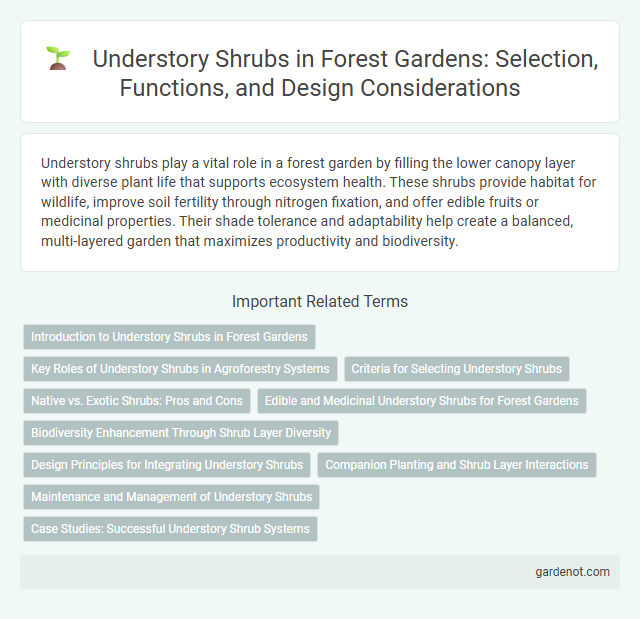Understory shrubs play a vital role in a forest garden by filling the lower canopy layer with diverse plant life that supports ecosystem health. These shrubs provide habitat for wildlife, improve soil fertility through nitrogen fixation, and offer edible fruits or medicinal properties. Their shade tolerance and adaptability help create a balanced, multi-layered garden that maximizes productivity and biodiversity.
Introduction to Understory Shrubs in Forest Gardens
Understory shrubs in forest gardens play a crucial role in creating layered ecosystems by occupying the intermediate vertical space between canopy trees and ground cover plants. These shrubs contribute to biodiversity, provide habitat for wildlife, and produce valuable yields such as fruits, nuts, and medicinal herbs. Common examples include hazelnut (Corylus avellana), elderberry (Sambucus nigra), and serviceberry (Amelanchier spp.), which thrive in partial shade and enhance soil health through natural nutrient cycling.
Key Roles of Understory Shrubs in Agroforestry Systems
Understory shrubs in agroforestry systems play a crucial role in enhancing biodiversity by providing habitat and food sources for pollinators and beneficial insects. They contribute to soil health through nitrogen fixation and organic matter addition, improving nutrient cycling and moisture retention. These shrubs also act as natural windbreaks and shade providers, which protect crops and reduce soil erosion in forest garden environments.
Criteria for Selecting Understory Shrubs
Selecting understory shrubs for a forest garden requires prioritizing shade tolerance, soil adaptability, and low maintenance needs to ensure healthy growth beneath the canopy. Species that support local biodiversity and provide edible or medicinal benefits enhance the garden's sustainability and ecosystem services. Shrubs with deep root systems improve soil structure and moisture retention, critical for long-term forest garden resilience.
Native vs. Exotic Shrubs: Pros and Cons
Native understory shrubs in forest gardens support local ecosystems by providing habitat for indigenous wildlife and promoting biodiversity, while exotic shrubs can introduce invasive species risk and disrupt soil nutrient cycles. Native species typically require less maintenance and adapt better to local climate conditions, enhancing sustainability. Exotic shrubs may offer unique aesthetic traits or fruit varieties but often demand more resources and careful management to prevent ecological imbalance.
Edible and Medicinal Understory Shrubs for Forest Gardens
Edible and medicinal understory shrubs such as American spicebush (Lindera benzoin) and elderberry (Sambucus canadensis) thrive in forest gardens by providing valuable fruits and herbal remedies. These shrubs contribute to biodiversity, soil health, and pest control while offering nutrient-rich berries high in antioxidants and traditional treatments for colds and inflammation. Incorporating such understory plants enhances forest garden sustainability, supports wildlife, and supplies continuous yields of edible and medicinal products throughout the growing season.
Biodiversity Enhancement Through Shrub Layer Diversity
Understory shrubs in forest gardens play a critical role in enhancing biodiversity by creating multiple habitat layers that support diverse wildlife and beneficial insects. Species such as hazelnut, elderberry, and currant increase structural complexity and provide food sources, shelter, and nesting sites for pollinators, birds, and small mammals. Integrating a variety of native and adapted understory shrubs promotes ecological resilience and nutrient cycling within the forest garden ecosystem.
Design Principles for Integrating Understory Shrubs
In forest garden design, understory shrubs play a crucial role by occupying mid-layer spaces that maximize vertical biodiversity and resource use efficiency. Selecting shade-tolerant plants with complementary rooting depths ensures minimal competition and enhances soil health through nitrogen fixation or organic matter contribution. Strategic placement of these shrubs between canopy trees and groundcover plants supports wildlife habitat while improving microclimate regulation and nutrient cycling.
Companion Planting and Shrub Layer Interactions
Understory shrubs in forest gardens play a crucial role in companion planting by enhancing biodiversity and creating beneficial microclimates that support the growth of surrounding plants. Their dense foliage and root systems improve soil health through nutrient cycling and moisture retention, while providing habitat for pollinators and pest predators. Strategic placement of understory shrubs within the shrub layer fosters synergistic interactions that increase overall resilience and productivity in forest garden ecosystems.
Maintenance and Management of Understory Shrubs
Regular pruning of understory shrubs prevents overcrowding and promotes healthy growth by allowing adequate light and air circulation. Mulching helps retain soil moisture and suppress weeds, reducing the need for frequent watering and manual weeding. Monitoring for pests and diseases early ensures timely intervention, maintaining the shrubs' vitality and supporting overall forest garden biodiversity.
Case Studies: Successful Understory Shrub Systems
Successful understory shrub systems in forest gardens demonstrate increased biodiversity and soil health, with species like Amelanchier alnifolia and Ribes nigrum thriving in shaded conditions beneath canopy trees. Case studies reveal these shrubs contribute to pest resistance and improved nutrient cycling by attracting beneficial insects and supporting mycorrhizal networks. Long-term monitoring highlights their role in enhancing multi-layered plant interactions and sustaining sustainable food production in agroforestry models.
Understory shrub Infographic

 gardenot.com
gardenot.com